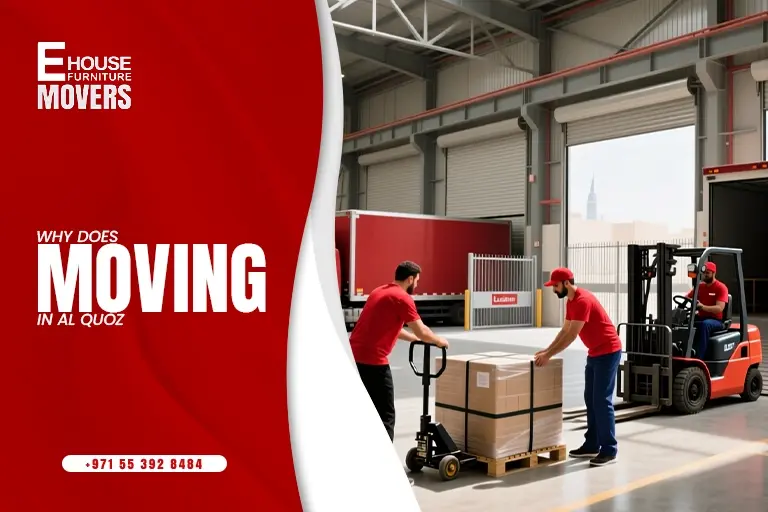A relocation from Abu Dhabi to Dubai requires a structured packing order, approved truck parking, scheduled elevator access, and a labeled delivery floor plan because the inter-emirate route, high-rise building regulations, and long-distance transit conditions determine how items must be boxed, loaded, transported, and unloaded.
The distance between Abu Dhabi and Dubai generally ranges from 140 to 160 km, depending on origin and destination towers. This long route requires careful load balance, secure wrapping, sequencing of items, and correct fragile-top layering. Dubai buildings require move-in permits, truck registration, and service elevator bookings, making precise timing critical. A pre-labeled floor plan allows movers to place furniture and boxes in correct rooms without rework. This article covers every operational detail needed for a smooth Abu Dhabi → Dubai move.
Table of Contents
ToggleWhy does moving from Abu Dhabi to Dubai require a specific packing and delivery sequence?
The move requires a sequence because long-distance trucking, building security rules, and the delivery-floor layout decide the order in which items must be boxed, loaded, transported, and unloaded.
Key reasons include:
- Inter-emirate distance increases vibration, requiring heavy-bottom and fragile-top packing.
- Dubai towers enforce specific delivery hours, making timing essential.
- Floor-plan–based unloading ensures correct placement during the first attempt, avoiding corrections.
- Truck parking approvals determine when the mover can begin unloading.
- Sequence errors cause congestion at elevators, damage during transit, and misplacement inside the apartment.
How does the Abu Dhabi → Dubai route affect packing order?
The route affects packing order because items must withstand 1.5–2 hours of continuous road vibration, requiring a stable bottom layer, centered weight, and cushioned top layers.
Professional movers follow these operational requirements:
- Heavy furniture (sofas, cabinets, tables) forms the bottom load.
- Medium-weight items (boxed kitchenware, electronics) form the middle layer.
- Fragile items (glass, décor, monitors) form the final top layer.
- First-delivery items are placed nearest the truck door for immediate unloading.
- Last-delivery items (garden tools, spare boxes) go deeper inside the truck.
This prevents item shifting, breakage, or tilt during long-distance travel.
What packing order do movers follow for long-distance moves?
Movers follow a packing order that starts with room grouping, continues with protective wrapping, and ends with load sequencing designed for safe inter-emirate travel.
1. Room-by-room grouping
- Each room is packed and taped before the next begins.
- Labels are assigned using a consistent code (BR1, BR2, LR, K).
- Bathroom items are boxed separately due to liquids.
2. Protective wrapping
- Sofas wrapped in moving blankets + stretch film.
- Mattresses wrapped in waterproof covers.
- Electronics wrapped with anti-static bubble wrap.
- Frames wrapped with corner guards.
3. Box classification
- Fragile boxes marked in red.
- Heavy boxes marked in black.
- Priority boxes marked in yellow.
4. Load sequencing
- Heaviest items loaded first.
- Vertical placement for mirrors, wardrobes, mattresses.
- Fragile items loaded last for first-off unloading.
Why is floor-plan labeling important for an Abu Dhabi → Dubai move?
Floor-plan labeling is important because it eliminates placement errors, reduces unloading time, and prevents movers from guessing room assignments inside the Dubai apartment.
A floor plan includes:
- Room codes: BR1 (Master), BR2 (Guest), LR (Living Room), K (Kitchen).
- Furniture placement markers: Bed zone, sofa zone, dining zone.
- Walking paths: Clearances between furniture.
- Stack zones: For boxed items.
- No-load zones: Areas where nothing should be placed.
The team uses the map to avoid double handling.
How do movers use a delivery floor plan inside Dubai buildings?
Movers use the delivery floor plan by matching each item’s label with the correct room and placing furniture exactly as shown on the map.
Sequence followed:
- Crew leader stands inside with the plan.
- Elevator runner announces each item code.
- Inside crew places items in exact mapped positions.
- Heavy furniture is placed before box stacking.
- Box stacks are arranged in rows along the indicated walls.
- Walkway clearance is maintained for movement.
This avoids reshuffling after setup.
How do parking rules affect delivery timing in Dubai buildings?
Parking rules affect timing because buildings restrict truck entry, require pre-booked slots, and enforce security verification before unloading begins.
Common rules include:
- Truck must be registered with building security.
- Move-in permit must be shown at the parking gate.
- Service elevator must be booked for the exact time.
- Trucks can only park in loading bays, not visitor parking.
- Peak hours (like school drop-off times) may be restricted.
- Access windows typically fall between 9 AM and 6 PM.
Delays occur if any approval is missing.
What parking requirements do movers follow in Abu Dhabi before departure?
Movers follow parking requirements that include move-out permits, loading bay reservations, and security gate verification.
Steps include:
- Move-out permit is issued by building management.
- Security verifies mover details.
- Truck parks in designated loading zones.
- No blocking of resident paths.
- Items are moved through the service elevator only.
- Final verification occurs before the truck exits and heads to Dubai.
Why do movers conduct a fragile-first unload in Dubai?
Movers conduct a fragile-first unload because fragile boxes and sensitive electronics must be placed in safe zones immediately to prevent damage during high-traffic unloading.
Fragile-first unload reduces risks associated with:
- Narrow hallways
- Elevator congestion
- Heavy-item collisions
- Dust or moisture at loading bays
- Accidental kicking or dropping
Fragile items go directly into low-traffic corners or protected bedroom zones.
How do movers protect fragile items during the Abu Dhabi → Dubai journey?
Movers protect fragile items using reinforced cartons, bubble wrap, foam lining, corner guards, and top-placement within the truck.
Protection methods include:
- Double-wall boxes for glassware.
- Foam sheets for plates and ceramics.
- Soft blankets for mirrors and frames.
- Anti-static wrap for laptops and TVs.
- Vertical positioning for frames to reduce pressure.
How do Dubai building floor plans affect item placement during unloading?
Dubai floor plans affect unloading because room sizes, door widths, elevator dimensions, and corridor layouts determine where each furniture piece can be placed.
Important considerations:
- Sofas may require angled entry into living spaces.
- Large wardrobes must pass through elevator doors.
- Beds must be assembled in mapped areas to prevent repositioning.
- Corridor clearance must be maintained for mover flow.
- Kitchen items must be placed close to cabinets for easier stocking.
How do movers manage unloading flow inside high-rise Dubai buildings?
Movers manage unloading flow by separating tasks between elevator runners, in-unit receivers, and truck loaders for smooth sequencing.
Operational structure:
- Runner team moves items from truck to elevator.
- Elevator controller cycles loads efficiently.
- Inside team directs placement via the floor plan.
- Assembly team builds beds, tables, wardrobes.
- Supervisor verifies against item list and plan.
What building management rules govern Abu Dhabi move-outs and Dubai move-ins?
Rules include mandatory permits, truck registration, elevator scheduling, and security verification at both origin and destination buildings.
Common requirements:
- Move-out permit (Abu Dhabi)
- Move-in permit (Dubai)
- Emirates ID or passport copy
- Tenancy contract copy
- EJARI or Tawtheeq where applicable
- Mover trade license
- Elevator booking confirmation
How do movers secure items during long-distance transport?
Movers secure items using ratchet straps, tie-down anchors, non-slip mats, stabilizer bars, and padded walls inside the truck.
Load-securement steps:
- Heavy furniture strapped to anchor points.
- Boxes arranged to eliminate gaps.
- Appliances braced with side-guards.
- Mattresses tied vertically.
- Mirrors placed between padded panels.
What factors should clients consider when choosing movers for Abu Dhabi → Dubai relocation?
Clients should consider packing quality, long-distance transport experience, permit management capability, floor-plan execution skill, and understanding of high-rise building rules.
Essential traits:
- Proven fragile-handling methods
- Understanding of parking restrictions
- Ability to coordinate elevator bookings
- Skilled assembly/disassembly team
- Accurate label-based unloading
Summary
A move from Abu Dhabi to Dubai requires a structured packing sequence, approved truck parking, and a labeled delivery floor plan because long-distance transport, building access rules, and high-rise layouts determine how items must be loaded, secured, and positioned on arrival. The correct order begins with room-based packing, heavy-bottom loading, fragile-top placement, and last-load/first-unload essentials. Abu Dhabi buildings require move-out permits and loading bay reservations, while Dubai towers require move-in permits, truck registration, and service elevator bookings. Movers follow floor-plan labeling to position furniture and boxes in exact room zones without errors. Secure transit methods, elevator sequencing, and unloading protocols ensure that items arrive safely, efficiently, and in the correct mapped locations.
Also Read: Moving from Dubai to Abu Dhabi: What Move Day Looks Like




